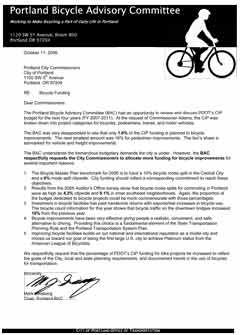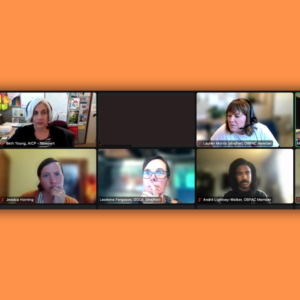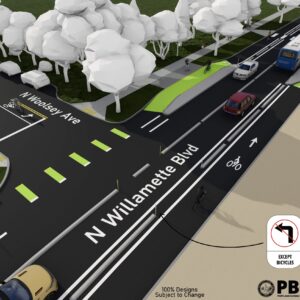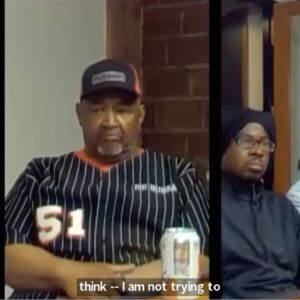Now that City of Portland Transportation Commissioner Sam Adams’ has told the Willamette Week about his dissatisfaction with the amount of money PDOT spends on bikes, I thought I would share a bit of background on the issue.
(This is a bit wonky…you’ve been forewarned.)
Back in September of 2006, the City of Portland released their Capital Improvement Project (CIP) budget for 2007-2011. At the request of Sam Adams, for the first time ever, the CIP was broken down into separate project categories for various modes of travel including; bikes, pedestrians, transit, and motor vehicles.
This breakdown was then reviewed and discussed by the City’s Bicycle Advisory Committee (BAC), a group that meets monthly to “advise City Council and all the bureaus on bicycle-related matters” (the City’s bicycle coordinator attends as a liaison between the committee and the City).
When the committee noted that PDOT’s CIP budget allocated only 1.6% of its funds to bicycle improvements, they wrote a letter to all five City Commissioners stating they were “very dissapointed” in that figure.
The letter noted that this 1.6% was the smallest amount of any mode in the city (the next smallest being pedestrian projects that garnered 16% of funds), and that “the lion’s share is earmarked for vehicle and freight improvements.”
Here’s a longer excerpt from the letter (download letter here (jpg)):
“The BAC understands the tremendous budgetary demands the city is under, however the BAC respectfully requests the City Commissioners to allocate more funding for bicycle improvements for several important reasons:
- The Bicycle Master Plan benchmark for 2006 is to have a 10% bicycle mode split for the Central City and a 6% mode split citywide. City funding should reflect a corresponding commitment to reach these objectives.
- Results from the 2005 Auditor’s Office survey show that bicycle mode splits for commuting in Portland were as high as 4.2% citywide and 9.1% in inner southeast neighborhoods. Again, the proportion of the budget dedicated to bicycle projects could be more commensurate with those percentages.
- Investment in bicycle facilities has paid handsome returns with exponential increases in bicycle use. The bicycle count information for these year shows that bicycle traffic on the downtown bridges increased 18% from the previous year.
- Bicycle improvements have been very effective giving people a realistic, convenient, and safe alternative to driving. Providing this choice is a fundamental elements of the State Transportation Planning Rule and the Portland Transportation System Plan.
- Improving bicycle facilities builds on our national and international reputation as a model city and moves us toward our gal of being the first large U.S. city to achieve Platinum status from the League of American Bicyclists.
We respectfully request that the percentage of PDOT’s CIP funding for bike projects be increased to reflect the goals of the City, local and state planning requirements, and documented trends in the use of bicycles for transportation.”
The letter was signed by committee Chair and Portland bike lawyer Mark Ginsberg. In a conversation this morning, Ginsberg said that while bike spending has “gradually improved” since the committee drafted this letter, he note’s “we’re still far behind” where we should be.
Ginsberg also points out that the spending issue should not be seen as an “us versus them” dichotomy. “Spending on bike improvements benefits all road users at a much higher return than tradition, motor vehicle-centric highway improvements. When you make biking safe, and more people choose to bike, it’s one less person adding to congestion…it makes the roads better for everyone.”
Download the letter here (jpeg).







Thanks for reading.
BikePortland has served this community with independent community journalism since 2005. We rely on subscriptions from readers like you to survive. Your financial support is vital in keeping this valuable resource alive and well.
Please subscribe today to strengthen and expand our work.
Hey, BAC, do you really want to encourage more bicycling by increasing funding for SUICIDE slots to create more ghost-bikes?
If you want to make it safer for bicycling, DON\’T do more suicide slots. Just LOWER the speed limit and enforce it with traffic calming. How much rocket science do you guys need for THAT?
Maybe even lose the traffic lights? Naaaaaaaah. Probably way ahead of your time. I hope Watzig\’s taking NOTES.
That\’s a good point I never really considered. Spending $10 million to improve ease of bike travel in the city would do more to decrease automobile congestion than $10 million on any other street improvement ever would. More bang for the buck. And that benefit is above and beyond the direct benefit cyclists receive from the $10 million. Great argument.
Well, Paul – \”suicide slots\” are only a portion of bicycle infrastructure – the BAC is arguing for more funding. Once we actually *get* it, then perhaps we can argue about how those funds should be spent.
Traditionally, PDOT has utilized bike funds to do a large number of different types of bike infrastructure projects – keeping all the options in the toolbox open, not just trying one thing and replicating it wholesale. That\’s one of the reasons why Portland\’s current infrastructure is as effective as it is.
Matt, I stand to be CORRECTED. My bad. But, you do have to admit \”Once we actually *get* it, then perhaps we can argue about how those funds should be spent,\” sounds like (gulp) EMPIRE building? Naaaaaaaah. SUMBODY shoot me ALREADY.
Paul, if we wait until we agree on the particulars, nothing will ever get done.
If you think PDOT has mismanaged the entire bicycle allocation since 1992, how about providing specific examples? Bikelanes comprise less than half the infrastructure, IIRC.
I don\’t believe PDOT is doing a horrible job (just the opposite, in fact – they\’re outstanding for the most part), and it\’s hard to argue with the results – a higher rideshare than anyone else in the country, best bikeable city, one of the most liveable cities, etc. If they\’re doing such a bad job creating places for people to bike, where is the evidence?
If PDOT were only building bike lanes, then you\’d have a leg to stand on. Give me some facts specific to Portland, and maybe you\’ll have a few converts over here.
So far, I read lots of complaints from you, but no alternatives, and no action. How about examples of successful alternatives you\’ve implemented in Tulsa? Things we can try here in Portland?
respectfully,
matt p
Matt, I have ALREADY provided alternatives.
1) LOWER the speed limit and use traffic calming to enforce it. If you are talking about safely accommodating bicycles on ALL streets, there\’s is NO reason why 40mph should be allowed. Like Tulsa, your roadway design ENCOURAGES impatient motorists to CRIMINALLY speed just to make the red.
2) Lose traffic lights. This week\’s ice storm in Tulsa knocked out power to the traffic lights. Has there been MORE crashes at the intersections? NO. And, Tulsa traffic engineers KNOW it.
3) Lose bike lanes and bike boxes. You aren\’t losing any rights on the rights you ALREADY have BEFORE bike lanes. What are bike boxes? One great big huge USELESS blue SLIPPERY ink spot on the road.
Specific results of BAD geometric design:
1) Sparling hit
2) Jarolemick hit
3) Siobahn hit
All on bike lanes. All within PDOT jurisdiction.
Yes, PDX has America\’s highest bike ridership. Yes, you have the most bike lane mile than ANY American city. But, the COLD fact is you guys are KILLING more bicyclists than ANYONE else on a regular basis on bike lanes. I challenge you to compare your numbers with NYC and SFO.
Yes, part of the reason why Tulsa hasn\’t killed an ADULT cyclist in the last 365 days is because of the low, probably miniscule, ridership.
Though the City of Tulsa itself hasn\’t implement ANY real specific infrastructure for bicyclists, ie. bike lanes, I\’d probably would NOT use them if they did. Why should government ENCOURAGE more ghost-bikes?
I get around wherever I want, including the expressways, without much problems, without bike lanes, without bike boxes. Traffic lights don\’t even work for bikes.
I wish I had more company who know how to game the system. For whatever reason, most people around here just don\’t want to bother. It gets lonely here.
But, I bet if Tulsa Mayor got out front and center, in public, and say, \”Hey, everybody, get off yer FAT arse, PEDAL,\” maybe the ridership might go up by 10. 11, if she rides too.
Oklahomans are naturally lazy asses, too tied to their SUV\’s for now. We haven\’t caught up yet. Most Okies think you guys up in PDX are COMMUNISTS.
Stuff that would make sense for Portland and Tulsa?
1) Lose FREE car parking and the associated zoning codes that require developers put in HUGE parking lots. See Shoup\’s The High Cost of Free Parking.
2) Include bicycle questions in the drivers\’ test. Oklahoma already does a great job in the manual. But, I\’ve asked DPS for the bike questions.
3) And, of course, get the cops and the law to be more EVEN-handed.
WOW!! Someone\’s been drinking from the John Forester punch bowl a bit too much. Not that there aren\’t some problems with Portland\’s bike lanes and not that some of your ideas, Paul aren\’t good ones but bike lanes are not all that bad when done and implemented in the proper places and when you understand who they are built for.
So Paul, I bet you ride a drop bar bike at a fairly fast pace around 15mph give or take a couple mphs. You probably wear special bike cloths a break a sweat every time you ride. I used to do the same and I\’ll tell ya\’ out here in NJ we ain\’t got squat for bike lanes but I did okay for the most part (and still do) when I would ride the high-end road bike out on the streets.
But know I\’ve found the joys of the simple 3-speed town bike; the one that you sit upright on and comes with fenders, racks and a bell. I use it to ride to work in my office cloths for only 2 miles down a 4 lane 25 mph avenue (no bike lane of course even though hourly bike counts are as high as 100 per hour). I never had problems with cars when I bombed down the road at 18mph or more, but now that I\’m cruzin\’ at a slow relaxed 10mph things are much more scary.
You see facilities are pretty much unnecessary for advanced riders who go at a faster pace. My transition to the slow 3-speed however has put things into a who new perspective. You see, special facilities like \”suicide slots\” (got to remember that one) start to become much more crucial for slower riders and for those who are just beginning. The reason why cities like Copenhagen have such high ridership numbers because they have invested a great deal of money in infrastructure to make it easy for the total novice to ride a bike. Yeah these facilities suck for the advanced, racing style rider and can even be hazardous for those types of riders but they are perfect for the masses that ride bikes just to get around town. These masses don\’t even consider themselves \”cyclists\” or part of any movement. They just do what is normal for them to do. This just like how most Americans think that mobility comes from behind a gasoline powered steering wheel. They don\’t feel like they are part of any \”car movement\” either.
If you want the same high ridership numbers like you see in Amsterdam, Copenhagen and Muenster (Germany) then you will need to make riding easy for those who are currently driving their cars. It is not for us advanced riders that they will need to build these facilities for and that is where the problem lies. I don\’t always like what I see being built in Europe or the Americas either but I understand this reality.
Andy B, actually, I prefer the flat bars, fat tires, and a HUGE wire basket mounted the frame of a baby seat. I am BEYOND spandex.
I try to keep the speed on the down-low, around 10mph, especially on the busiest roads, and the expressways, during RUSH. Cops love it.
When I have to ride from one town to the next, I do try to make time.
It seems in a lot of ways Tulsa, without the bike lanes, is actually as safe place to ride as Portland and Copenhagen. You just need to understand how to game the system.
Unfortunately, not too many around here are willing to do so, even the spandex set. So, yeah, it gets kinda LONELY.
Andy, actually, I\’ve given up on high ridership numbers. It\’s gonna happen here when gas hits $7. Or it\’s not. I am probably just more interested in making the system work for me.
But, when I read about the crap that goes on in places like Portland, I do get kinda miffed. What\’s in it for me? Absolutely NOTHING.
Sometime around 3 a.m. this morning, it finally occurred to me that PDOT uses VOODOO and has NO bike-car collision study to prioritize funding for bike projects.
I got an request on here from Alison at CCC for the 1974 Ken Cross study. And, Greg Raisman made a similar comment over at C-Liciousness.
Both of which and Matt Picio\’s defensive stance on behalf of PDOT led me to that eureka moment. PDOT has NOT conducted a bike-car collision study. SPANK me, if I am WRONG.
Certainly, no one can dismiss the ENCOURAGEMENT value of bike lanes to increase ridership. My question is why should government ENCOURAGE more ghost-bikes NEXT to bike lanes?
What Forester said over 30 years ago has saved my life many times over. It\’s still relevant in Tulsa, Portland, and Copenhagen.
[Oklahomans are naturally lazy asses, too tied to their SUV\’s for now. We haven\’t caught up yet.]
Paul Tay, don\’t believe the hype. Most people here are lazy-asses tied to their SUVs, too.
[Most Okies think you guys up in PDX are COMMUNISTS.]
Ha! Ha! Ha! So true! My partner\’s relatives in the Florida panhandle think the same thing.
I would just love to have any money in a bicycle infrastructure budget where I live in Texas. The only problem we have is the heat, which can be dealt with just like people are used to dealing with coats and jackets in the winter. We don\’t have much in the way of hills to deal with (the last 2 \’bents I built for myself were single speed, one with a coaster brake). With a little common sense design for our streets, and reasonable speed limits (we actually have 35 MPH speed limits in residential areas, if you can believe that) we could have excellent bike riding even here.
Opus
FYI – Paul Tay lives in Tulsa OK, and works on bicycle/transportation issues there (at least that\’s what I gathered from his blog). Not sure why he is obsessed with commenting on funding fro bike infrastructure in Portland OR, but apparently some people have time to spare on their hands. Nor am I sure why I\’m engaging his thread of comments, but I\’ll just say this: where exactly in this letter from our committee do you see mention of \”suicide slots\”? This letter is a general call for the City of Portland to spend a percentage of the transportation CIP budget on \”bicycle improvements\” that is at least equal to the percentage of people using that mode. That could be any number of capital improvements, including amenities for bike boulevards. sorry. I guess I SHOULD have capitalized a few random words TO get my point ACROSS better.
Well said Shamus. It seems so often blogs become counterproductive dialog. The infrastructure elements are not without controversy but I hope we can all agree that more of it, generally, is a good thing. I certainly like the idea of slower speed limits but it may be wise to wait until ridership justifies the change. If motorists are forced to go 15 or 20mph on an empty road, they might push for a reversal. If the road is populated with bikes, it should make the lower limits more palatable.
Bike lanes make sense under certain circumstances. A global acceptance or rejection of them misses the complexity of road design.
Paul (#6) – I asked for successful alternatives Tulsa has implemented. You give plenty of recommendations, but have they already been tried successfully somewhere? What was the result?
As for Portland fatalities, we average 2 per year. How *does* that compare with NYC and SF since you apparently have already researched it?
It\’s easy to complain about the things we\’re doing here, it\’s not so easy to fix the problems. Change takes time. I\’d like to see a massive effort on driver education, but I don\’t expect it to happen overnight, nor without a lot of hard work by dedicated activists. I\’d like to see trucks with underrun protectors, better safety equipment, more mirrors, better visibility. All of that takes time, money and manpower to implement, all three of which are in short supply.
Until then, I think the best thing we can do is get as many people out on bikes as possible, because the more people are used to seeing us, the less they\’ll be surprised at our presence.
Well, and I\’d rather have company then ride alone – but that\’s a purely selfish reason.
Matt, Tulsa has NO specific bike program withing the City\’s geometric design group. Therefore, those of us who chose to bike for transportation compensate. Which is not altogether that bad, and probably as safe as Portland.
There is a HUGE potential for right-hooks on the off-ramps of high-speed expressways like the Broken Arrow. To compensate, simply anticipate, stick out your left arm to slow traffic, catch a gap and make the cross.
It seems Portland bike lanes are your equivalent. Cross noted that right-hooks are common at these types of roadway treatments.
It\’s probably good to get as many people out on the bike as possible. But, if there is a PROVEN association between right-hooks and bike lanes, would you continue the ENCOURAGEMENT of ghost-bikes next to bike lanes?
#11, Shamus, YEP. I NEED a JOB! Way too much time on my hands.
Zaphod, #12, I\’d go for 25mph speed limit, and use traffic calming to enforce it. Sure, motorists will yell and scream if the speed limit is 25mph on a long, wide, STRAIGHT road.
But, what if the roadway is RE-designed to actually ENCOURAGE the 25mph speed limit? Ya think the lower speed limit might also save motorists\’ lives too? Naaaaaaaaaah.